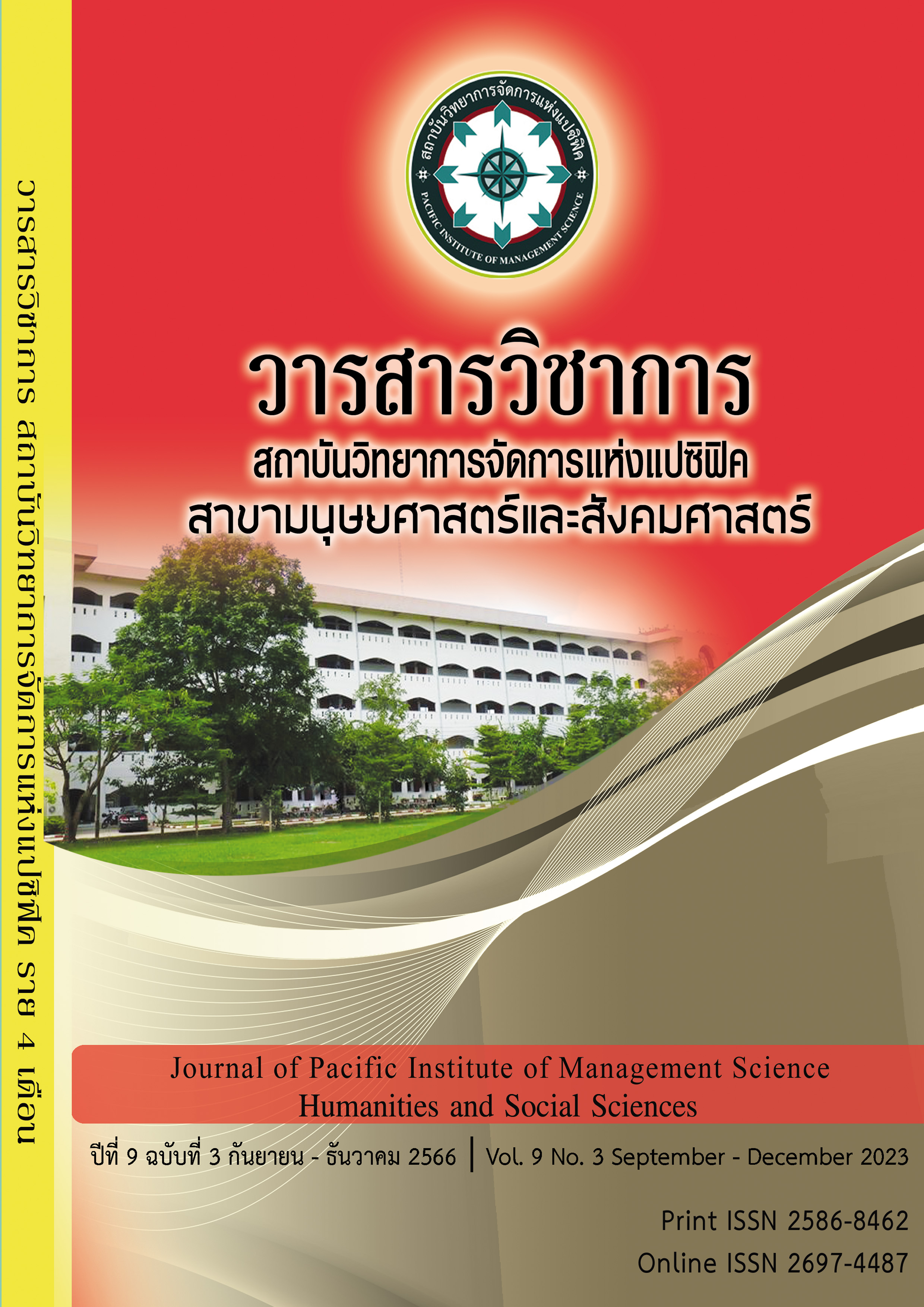Environmental Management in Elementary Schools
Keywords:
Environmental Management, Elementary SchoolAbstract
The purposes of this research were to 1) identify the environmental management in elementary schools, and 2) verify the factors of the environmental management in elementary schools. The research populations consisted of 26,905 schools under primary the Office of the Basic Education Commission, Ministry of Education. The samples were 100 elementary schools. The sample size was determined based on Yamane’s Sample Size Table. The sample was obtained from stratified random sampling. There were 300 respondents included school directors or or acting in the position of director of educational institutes, deputy school directors of educational institutions or head of general administration group and teachers. The research instruments were the semi-structured interview, the opinionnaire, and the confirmatory factor analysis opinionnaire of the environmental management in elementary schools. The statistics used to analyze the data were frequency, percentage, arithmetic, standard deviation, exploratory factor analysis, and content analysis.
The findings of this study were as follows:
1. The environmental management in elementary schools consisted of 5 components: 1) environmental management process, which comprised 3 sub-components: 1.1) Implementation of environmental management, 1.2) Evaluation of environmental management, 1.3) Development and improvement of environmental management 2) Environmental direction and policy setting 3) Executive Leadership 4) Review and follow up ; and 5) Defining environmental objectives and targets All components can be described as 68.422 percent.
2. Confirmation results of environmental management in elementary school were verified to meet with accuracy standards, properties standards, feasibility standards, and utility standards.
References
กรมควบคุมมลพิษ. (2565). ISO 14001. [ออนไลน์]. สืบค้นเมื่อ 20 สิงหาคม 2565. จาก https://www.pcd.go.th/iso.
ขวัญนรี กล้าปราบโจร. (2561). ความสัมพันธ์เชิงสาเหตุของการปฏิบัติการบัญชีเพื่อการจัดการสิ่งแวดล้อมที่มีต่อความยั่งยืนขององค์กรของบริษัทที่ได้รับการรับรองมาตรฐาน ISO 14001 ในประเทศไทย. วิทยานิพนธ์ปรัชญาดุษฎีบัณฑิต สาขาวิชาการบัญชี คณะบัญชี มหาวิทยาลัยศรีปทุม.
จุฑารัตน์ หงษ์จินดา และ จุฑารัตน์ ชมพันธุ์. (2557). ปัจจัยที่ส่งผลสำเร็จต่อการดำเนินงานระบบมาตรฐานการจัดการสิ่งแวดล้อม (ISO 14001) : กรณีศึกษาบริษัท พีทีที โกลบอล เคมิคอล จำกัด (มหาชน). วารสารการจัดการสิ่งแวดล้อม (Journal of Environmental Management) 10 (1) : 81-82.
ชาญชัย อาจินสมามาร. (2558). เด็กกับสิ่งแวดล้อมในโรงเรียน. กรุงเทพฯ: กรมการฝึกหัดครู.
นัทพงศ์ จันทมาศ. (2561). การเปลี่ยนแปลงครั้งสำคัญระบบการจัดการสิ่งแวดล้อม เป็นฉบับ ISO 14001:2015. EAU HERITAGE JOURNAL Science and Technology 12
(3) : 20-21.
บุญถึง นันตะก้านตรง (2560). การบริหารสิ่งแวดล้อมโดยระบบ ISO 14000 และวัฒนธรรมองค์การที่ส่งผลต่อประสิทธิผลองค์การภาคอุตสาหกรรม. วารสารวิจัยและพัฒนา วไลยอลงกรณ์ ในพระบรมราชูปถัมภ์ 12 (2) : 260.
มาลิน จำแม่น, วิสุทธิ์ สุนทรกนกพงศ์ และณัฐวุฒิ โรจน์นิรุตกุล. (2558). ปัจจัยที่ส่งผลต่อการ จัดการสิ่งแวดล้อมตามมาตรฐาน ISO 14001:2004 ของโรงงานในเขตพื้นที่ ไอ พี 5. ครุศาสตร์อุตสาหกรรม 14 (2) : 521.
มูลนิธิเพื่อการวิจัยและพัฒนาระบบยา. (2563). การจัดสภาวะแวดล้อมในโรงเรียน. [ออนไลน์]. สืบค้นเมื่อ 16 มกราคม 2563. จาก.http://phared.org/home/index.php?lang=th
วารี กุนาคำ, ชานินทร์ ศรีสุวรรณภา และณัฐวุฒิ โรจน์นิรุตติกุล. (2558). ปัจจัยที่ส่งผลต่อการจัดการสิ่งแวดล้อมตามมาตรฐาน ISO 14001:2004 ในโรงงานผลิตสีอุตสาหกรรม เฟส 8 นิคมอุตสาหกรรมอมตะนครจังหวัดชลบุรี. ครุศาสตร์อุตสาหกรรม 14 (1) : 246.
สรรพสิทธิ์ แก้วเฮ้า. (2565). การจัดการสิ่งแวดล้อมเพื่อความยั่งยืน. กรุงเทพฯ: จุฬาลงกรณ์ มหาวิทยาลัย.
สำนักงานรับรองมาตรฐานและประเมินคุณภาพการศึกษา (องค์การมหาชน). (2563). รายงานการสังเคราะห์ผลการประเมินคุณภาพภายนอกรอบสาม พ.ศ.2554-2558 ของสถานศึกษาขั้นพื้นฐาน. [ออนไลน์]. สืบค้นเมื่อ 16 มกราคม 2563. จากhttp://www.onesqa.or.th/upload/download/201704271505239.pdf.
สำนักนโยบายและแผนการศึกษาขั้นพื้นฐาน สำนักงานคณะกรรรมการการศึกษาขั้นพื้นฐาน, สถิติข้อมูลทางการศึกษา ปีการศึกษา 2565 [ออนไลน์]. สืบค้นเมื่อ 6 มกราคม 2566, เข้าถึงได้จากhttp://www.bopp.go.th/?page_id=1828
อลงกรณ์ อินทรทูต และจุฑารัตน์ ชมพันธุ์.(2558). ปัจจัยที่ส่งผลต่อการดำเนินงานระบบการจัดการสิ่งแวดล้อม (ISO 14001) ของอุตสาหกรรมปิโตเคมี: กรณีศึกษาบริษัทไออาร์พีซี จำกัด (มหาชน), ดุษฎีบัณฑิตทางสังคมศาสตร์ 5, 2 (พฤษภาคม-สิงหาคม 2558): 17,21-22.
อำนวย วัฒนกรสิริ. (2557). การจัดการสิ่งแวดล้อม. วิชาการเทคโนโลยีพลังงานและสิ่งแวดล้อม. 1 (1) : 48-51.
Tabachnick, Barbara G. and Fidell, Linda S. (1983). Using Multivariate Statistics. New York: Harper & Row.
Kahloot, Essam, Yaqout, Anwar and Khan, Pattan Bazieth. (2019). The impact of ISO 14001 standards certification on firms’ performance in the state of Kuwait. Journal of Engg 7 (3) : 286.
Arribaz, Jorge Antonio and Mediano, Catalina Martinez. (2018). The impact of ISO quality management systems on primary and secondary schools in Spain. Quality Assurance in Education 26 (1) : 2.
Cronbach, Lee J. (1984). Essentials of Psychological Tests. 4th ed. New York: Harper & Row.
Downloads
Published
Issue
Section
License
Copyright (c) 2023 Pacific Institute of Management Science

This work is licensed under a Creative Commons Attribution-NonCommercial-NoDerivatives 4.0 International License.
บทความที่ได้รับการตีพิมพ์เป็นลิขสิทธิ์ของ สถาบันวิทยาการจัดการแห่งแปซิฟิค
ข้อความที่ปรากฏในบทความแต่ละเรื่องในวารสารวิชาการเล่มนี้เป็นความคิดเห็นส่วนตัวของผู้เขียนแต่ละท่านไม่เกี่ยวข้องกับสถาบันวิทยาการจัดการแห่งแปซิฟิค และคณาจารย์ท่านอื่นๆในสถาบันฯ แต่อย่างใด ความรับผิดชอบองค์ประกอบทั้งหมดของบทความแต่ละเรื่องเป็นของผู้เขียนแต่ละท่าน หากมีความผิดพลาดใดๆ ผู้เขียนแต่ละท่านจะรับผิดชอบบทความของตนเองแต่ผู้เดียว







